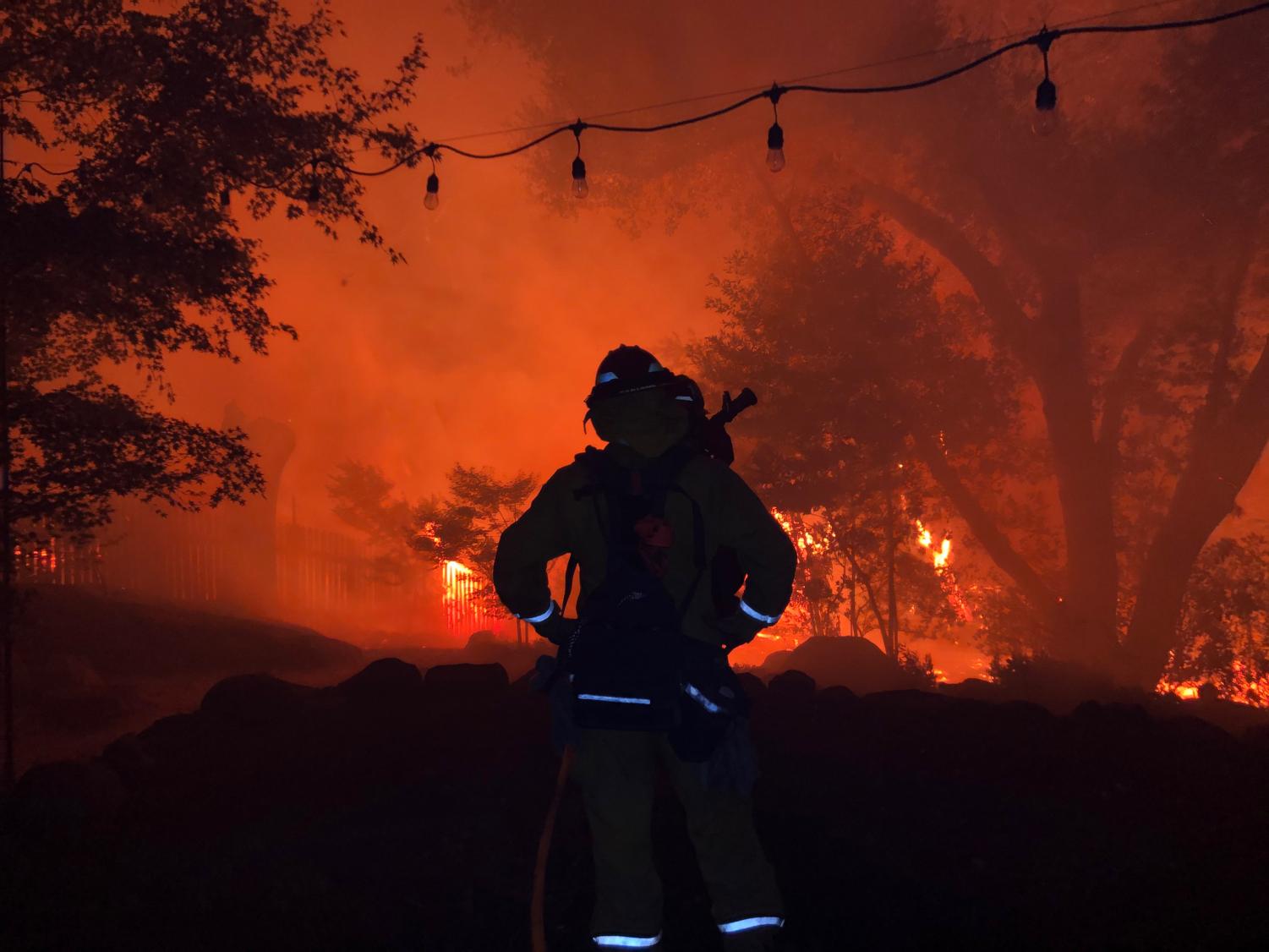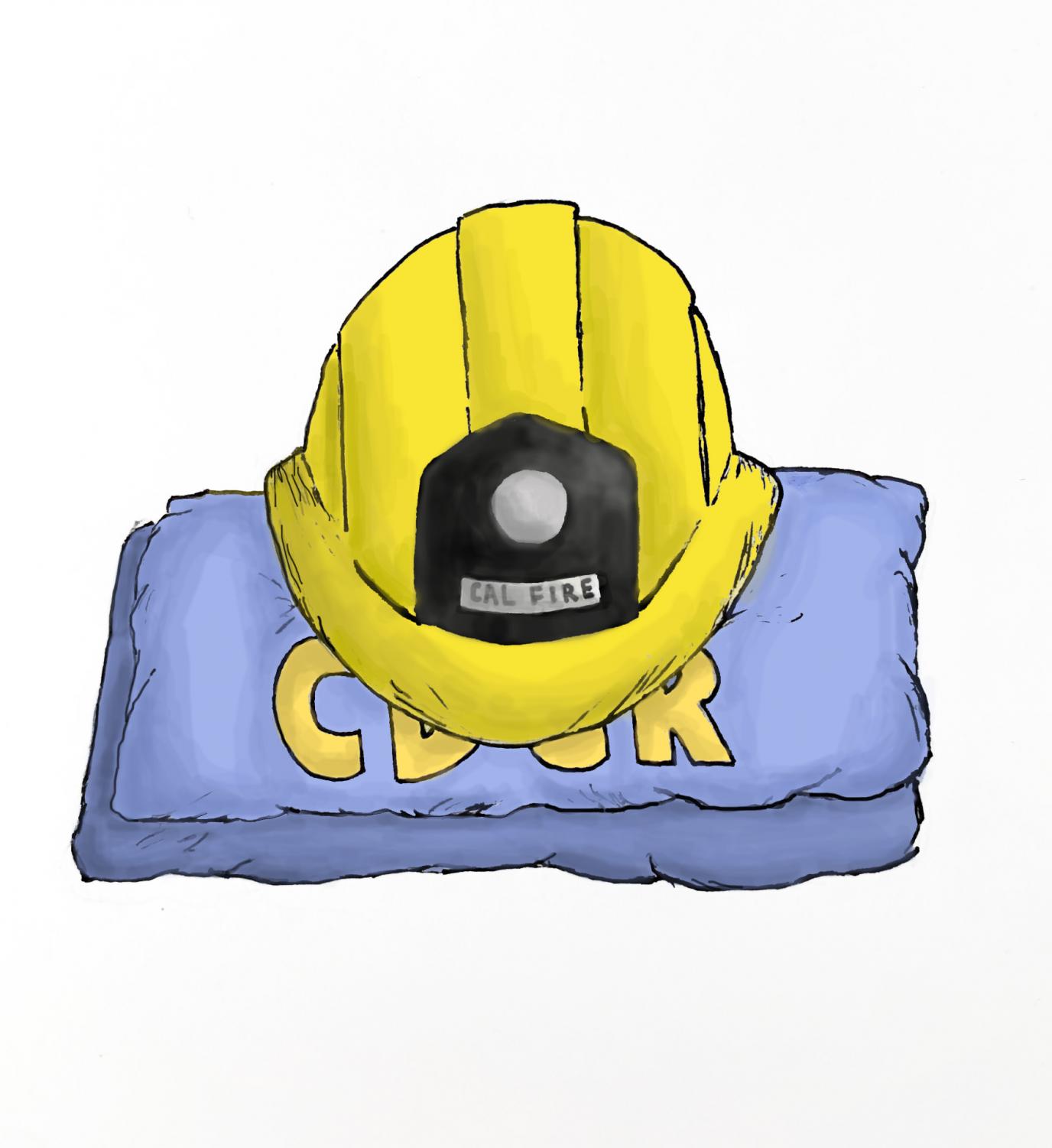Overlain in a coat of black ash, the dry brush distinctive to wine country crunches beneath quickly moving black boots. A cohort of firefighters clad in yellow and orange traverse the hills of Napa County, pursuing August’s Hennessey Fire as smoke blurs the distinctions of each suit’s color. The fire line is a domain of stress and quick work for those combatting California’s fires each year, but for the incarcerated individuals in orange, it is also a site of temporary exemption.
Inmate firefighters have been instrumental in California’s fire efforts since the mid-20th century, but the state’s deployment of these groups has proven especially critical as fire seasons have become an anticipated characteristic of increasingly dry autumns. To Central Marin Fire Chief Ruben Martin, “fire season has [seemed to be] a never ending process” this fall.
Though the now-doused Hennessey Fire stopped scorching areas north of Marin on Oct. 2, the contributions of inmate firefighter volunteers to the California Department of Forestry and Fire Protection (Cal Fire)’s efforts were a recent example of the resoluteness their work demands.
Roan Burns, a second-year firefighter currently serving Marin County Fire’s Woodacre headquarters, collaborated with these incarcerated volunteers on the scene. Most recently wedged between Sonoma and Napa County as his strike team combatted the Glass Fire, Burns had operated on 24-hour shifts for upwards of 60 days, but distinctly remembers the tenacity of those inmate crews just weeks ago.
“When the Hennessey Fire first started, our assignment was to wrap a spotfire with a hose, and we were working with a lot of these inmate crews, who work extremely hard. We laid hose up this hill and then we cut a line down the hill and made a dirt line so the fire couldn’t burn over it. The inmates met us halfway up the hill and they were super fatigued; I mean, some of those guys were puking,” Burns said. “That night, we all crashed together up on the hillside.”
Incarcerated volunteers brace for this level of arduous work, a normality of a typical firefighter’s daily routine, through Cal Fire’s conservation camp training that parallels the preparation of seasonal firefighters. According to the California Department of Corrections and Rehabilitation (CDCR), approximately 3,100 inmates currently work at the state’s 43 fire camps, 2,200 of which are fire line-qualified inmates.

The pandemic’s slimming effect on prison populations has effectively reduced these numbers, though: an Aug. 6 ABC News article cited state prison officials who estimated that as many as 17,600 California prisoners could be sent home in attempts to mitigate the spread of COVID-19 in state facilities. To incentivize incarcerated individuals demonstrating good character behind bars to join this ever-thinning numbers of volunteers, CDCR awards most with 2-for-1-credits, meaning incarcerated firefighters can earn two days off their sentence for every one day of service.
On site, incarcerated volunteers are typically tasked with assignments that are equivalent in intensity to those of professional firefighters, which often take life-risking forms. However, a vital discrepancy between the groups lies in their differences in pay. Inmate firefighters can earn between $2 to $5 per day with a $1 boost for every hour spent fighting fires, while the average base salary for California’s firefighters sits at $54,247, a value soaring 23 percent higher than the national mean. This stark contrast in earnings only deepens when the amount of money inmate volunteers save the state is considered: according to The Guardian, this value sits around $100 million each year.
Upon release, some incarcerated firefighters have found employment with Cal Fire through an existing program, but for most, criminal records have acted as immense roadblocks to occupations, initiating a cycle often resulting in re-arrests and re-imprisonment. For years, petitions condemning these blockades have flooded websites like Change.org, amassing hundreds of thousands of signatures. Such calls for reform were answered on Sept. 11 when Governor Gavin Newsom signed Assembly Bill (AB) 2147 allowing volunteer incarcerated firefighters to become professional firefighters upon release via newly created eligibility for record expungement, granted only to those with nonviolent backgrounds. Passed by a 51-12 majority in the California State Assembly and a unanimous 30-0 vote in the Senate, the law aims to address California’s problem of recidivism, or the return of a formerly incarcerated person to prison.
It also appears to be a strive toward recognizing the “integral [role inmates hold] to the whole fire service,” as volunteer firefighter Mike Carlson puts it.
“I think [AB 2147] is great; it creates a whole new opportunity for people who otherwise would be denied the opportunity at a job that [many] have spent years working [at],” Carlson said.

Government officials have voiced similar sentiments about the legislation’s implications. In an Aug. 31 tweet prior to its signing, bill author and Democratic Assemblywoman Eloise Reyes wrote, “#AB2147 heads to the Governor. If we really want to bring about change and lower our recidivism rates, we have to ensure that those who have served their sentences have an opportunity for meaningful employment. Those that have served on the fire lines deserve a second chance.”
Reyes’ desire to reduce these recidivism rates comes at an appropriate time: according to CDCR, California’s rate has averaged above 50 percent over the past decade. In just the 2017-2018 fiscal year, 62 percent of the state’s inmates being released were assessed as “at risk” of returning to prison.
In Sacramento, the Governor’s office was met by “overwhelmingly positive” responses to AB 2147, but there has been a long road to this point.
“Legislation like this has faced challenges — a number of bills that would help to clear an inmate’s record do not make it through the legislature. That said, there seems to be a new trend towards ensuring that inmates do not face roadblocks…when reentering society,” the Office of the Governor said in an email to the Bark.
To some, this bill’s signing transcends the issues of recidivism or previous pushback from state legislators. Troy Williams was formerly incarcerated at San Quentin State Prison, and this October marks the six-year anniversary of what he dubs his “freedom day.” After helping start the prison’s radio program inside its walls and accepting an award from the Society of Professional Journalists on behalf of the program following his release, Williams has taken his experience outside, recently forming the non-profit organization Restorative Media, which works to “develop transformative stories [in film] for social change.” Though AB 2147 is deemed a recent progression by many, Williams holds that legislation like this is long overdue.

“It kind of blows my mind that we even have to have this conversation…If I can [theoretically] work on the firefighter crew and understand the job and put my life at risk for [about] a dollar a day when I’m incarcerated, why can’t I do that in the free world to keep me out [of prison]? To keep me safe? To put me amongst the rest of the heroes that risk their lives protecting our citizens’ properties and lives?” Williams said. “I’m appreciative in one sense that there is some recognition going towards these gentlemen who have been fighting fires from inside of our prison system, but this bill needs to go further.”
Perhaps the most mixed reactions to AB 2147 have arisen from those it most directly affects. Rasheed Stanley-Lockheart is a formerly incarcerated firefighter who served in San Quentin’s Fire Department for two and a half years, during which he accumulated the titles of emergency medical technician and leader of the ambulance and medical crew. Though the work firefighting necessitated at times risked his life, he also found that, in a sense, it saved it.
“There’s this sense of purpose and pride that comes from being brothers at arms, going into life-or-death situations together, having a sense of connection that’s unlike anything I’ve ever experienced,” Stanley-Lockheart said. “You’re talking [to] somebody who [is] a former gang member: [I] was doing it because [I] was looking for a sense of comradery, a sense of belonging, a sense of family…[At San Quentin], I was working with guys [on the fire squad] that would never even think about talking to me in my regular life, and now our lives depend on each other.”
Since his release in January, Stanley-Lockheart has been a keen criminal justice reform activist for incarcerated firemen and works for Planting Justice, a nonprofit in Oakland employing and supporting former inmates and underserved Bay Area communities through food justice initiatives. Although he considers AB 2147 a step in the right direction, he holds that there is more to be done in the bill regarding equal pay, automatic expungements of records and the validity of Cal Fire training certificates following release. Estimating that the record-clearing process in step with the time it can take aspiring professional firefighters to train could accumulate to a multiple-year path to employment, Stanley-Lockheart approaches the legislation with cautionary optimism.

“AB 2147 is not a solve-all and [doesn’t] eliminate a hurdle, but it actually kind of puts that hurdle a little further out,” Stanley-Lockheart said. “[Newly released men] are returning to the same systems that destroyed [them], but [they] now are in the mindset of ‘I want to be a firefighter; I want to be a hero…But everything [they] did on the inside is no good — it’s a lived experience that doesn’t count for anything. So, AB 2147 is [enacted]…but anything with the writ of habeas corpus can take over a year to get [expunged]. These [people] are looking at years until [they] can even think about becoming seasonal firefighters…Do you think [they’re] going to survive or return to prison?”
While Stanley-Lockheart took another occupational path upon his release, AB 2147 still appears to have sparked positive momentum for formerly incarcerated firefighters like him. Regardless of their status as firefighters or participants in any other rehabilitative programs, he hopes that this potential for widespread progress will be extended to all incarcerated people looking for more than just captivity in the near future.
“There are thousands just like me who are doing time and just waiting for their opportunity to get out. [They want to] have an impact on the community and advocate for change for those who don’t have voices on the inside…[Upon release,] there are ways to succeed out there…there is still some stigma about formerly incarcerated people, but things are changing,” Stanley-Lockheart said. “I’m 43 years old and that process is still a long, hard road, [but] what I do is I lend my voice in hopes of changing things for those who are on their way out, so in that way I am still a firefighter, right? I’m still locked into that comradery and am trying to have an impact.”
















